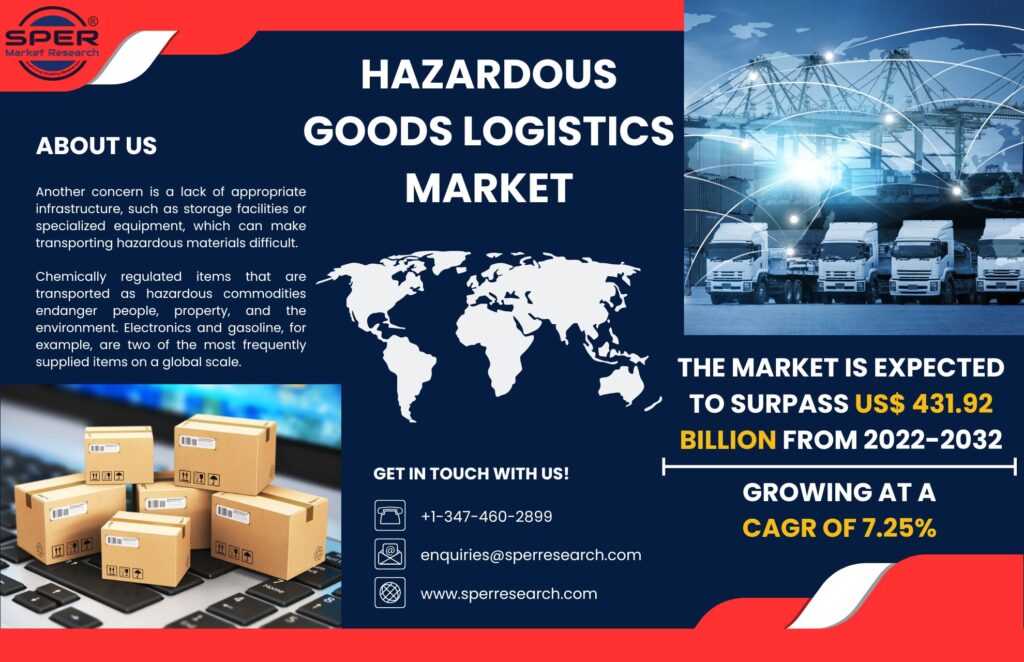Hazardous Goods Logistics Market Growth 2023- Global Industry Share, CAGR Status, Scope, Upcoming Trends, Business Challenges, Opportunities and Future Competition Report 2032: SPER Market Research

Any object or material that endangers one’s health, property, or the environment is considered a hazardous good. Hazardous products, which include commonly used products and products like cell phones, chemicals, bio-hazardous materials, and gasoline, account for a significant amount of international freight. Special training is required for those who transport and store hazardous commodities such as explosives, radioactive objects, combustible liquids, and biohazardous materials. Chemically regulated items that are transported as hazardous commodities endanger people, property, and the environment. Electronics and gasoline, for example, are two of the most frequently supplied items on a global scale. As a result, while shipping hazardous items, specific precautions, treatment, and packaging are essential.
According to SPER market research, ‘Hazardous Goods Logistics Market Size- By Business Type, By Operation, By Product, By Application- Regional Outlook, Competitive Strategies and Segment Forecast to 2032’state that the Hazardous Goods Logistics Market is predicted to reach USD 431.92 billion by 2032 with a CAGR of 7.25%.
Due to a number of factors, the global market for logistics services for hazardous goods provides numerous business prospects. First of all, growing trade globalization has led to a rise in the movement of hazardous goods across borders. The growth of industries including those in the chemical, pharmaceutical, and petroleum industries—all of which heavily rely on the transportation of hazardous goods—is driving this increase. As a result, there is a growing need for reliable and secure logistics options to handle these goods, opening doors for providers of hazardous goods logistics.
The market for hazardous goods logistics encounters some problems. Compliance with all of the authorities’ rules and regulations is a serious issue. Recognizing and sticking to these requirements can be difficult and time-consuming, and failure to do so may result in penalties. Safety is also a major concern, as hazardous materials can be hazardous if handled wrong. Accidents can happen as a result of human error or equipment malfunction. Another concern is a lack of appropriate infrastructure, such as storage facilities or specialized equipment, which can make transporting hazardous materials difficult. Insurance for these items is prohibitively expensive due to the risks involved.
Request For Free Sample Report @ https://www.sperresearch.com/report-store/hazardous-goods-logistics-market.aspx?sample=1
Impact of COVID-19 on Hazardous Goods Logistics Market
The COVID-19 outbreak has had a substantial influence on the worldwide hazardous goods logistics business. Lockdowns and travel restrictions disrupted supply networks, resulting in delays and higher pricing. Compliance with changing legislation and safety procedures created operational challenges. In contrast, the outbreak created opportunities as demand for medical supplies and pharmaceuticals surged. Logistics providers in these industries faced increased demand and played a crucial role in ensuring the timely delivery of essential items. The epidemic has accelerated the adoption of digitization and technology, allowing for greater supply chain visibility and operational efficiency.
Hazardous Goods Logistics Market Key Players:
Furthermore, the market in North America is driven by a large industrial foundation, particularly in the chemical, pharmaceutical, and oil & gas industries. Hazardous products transportation is governed by strict rules in the United States and Canada, necessitating the use of specialized logistical services. The existence of established logistics businesses with competence in handling hazardous chemicals and adhering to safety requirements provides to the growth of the market in this region. Additionally, some of the market key players are Hellmann Worldwide Logistics, Kuehne + Nagel, Rhenus Logistics, Toll Group, United Parcel Service, XPO Logistics, Ych Group, YRC Worldwide Inc, Yusen Logistics.
Hazardous Goods Logistics Market Segmentation:
The SPER Market Research report seeks to give market dynamics, demand, and supply forecasts for the years up to 2032. This report contains statistics on product type segment growth estimates and forecasts.
By Business Type: Based on the Business Type, Global Hazardous Goods Logistics Market is segmented as; Transportation, Warehousing, Value Added Services
By Operation: Based on the Operation, Global Hazardous Goods Logistics Market is segmented as; Seaways, Roadways, Railways, Airways, Storage and Services
By Product: Based on the Product, Global Hazardous Goods Logistics Market is segmented as; Flammable, Explosive, Radioactive, Bio-Hazardous, Others
By Application: Based on the Application Global Hazardous Goods Logistics Market is segmented as; Industrial, Healthcare, Agriculture, Others
By Region: The United States is the region’s largest donor. Rapid industrialisation, rising energy demands, more trade among neighbouring nations, and greater internationalization have all contributed to regional market expansion. Europe’s largest income sources are Germany, France, and the United Kingdom.
Saudi Arabia and the United Arab Emirates are the primary regional suppliers. The region is well-known for its crude oil drilling activities, and it has an important place in the worldwide oil and gas business. Saudi Arabia controls a significant portion of the world’s proven petroleum reserves. Increasing industrialization and rising disposable income have increased demand for different chemical goods, crude oil, oil products, and so on, boosting regional market growth.
For More Information, refer to below link:-
Hazardous Goods Logistics Market Future Opportunity
Related Reports:
Follow Us –
LinkedIn | Instagram | Facebook | Twitter
Contact Us:
Sara Lopes, Business Consultant – U.S.A.
SPER Market Research
+1-347-460-2899





